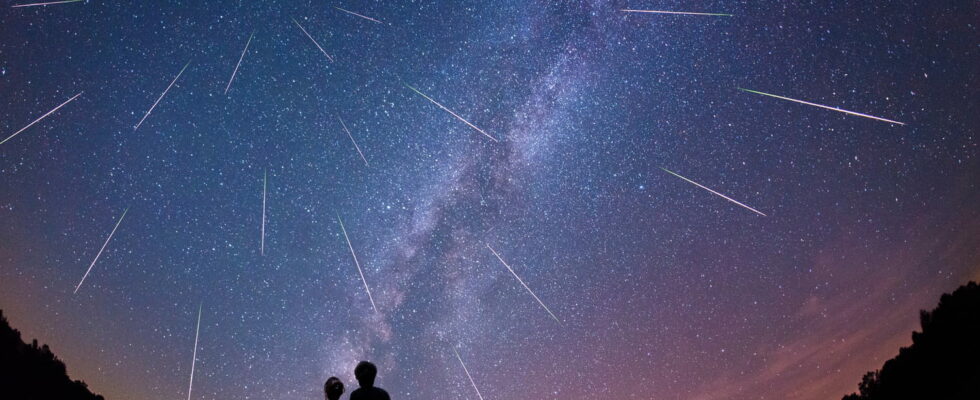The first shower of shooting stars of the year 2025 is about to light up this night of January 3. Time, location, viewing conditions, here is all the useful information to enjoy the show.
The celestial spectacle will be promising. It is after midnight, this night of January 3, 2025, that the Quadrantids, the famous shower of shooting stars at the beginning of the year, will be observable with the naked eye for the least tired amateurs. This year, “around 120 meteorites per hour” moving at a speed of “41 kilometers per second”, according to NASA, will be able to be observed by those most determined to stay awake or early risers. Indeed, the show will be just as big “in the early morning, around 6 or 7 a.m.”, according to Benjamin Peter, head of space news at the Cité de l’espace for BFM TV. If you can’t make it, don’t panic, the night “from the 3rd to the 4th shouldn’t be neglected” either. Then, the Quadrantids will be observable until January 12, although their peak activity occurs now.
Good news, the observation conditions look favorable for this nocturnal spectacle because the peak occurs during the moon increasing. If a shooting star often lasts only a fraction of a second, it is preferable to carefully contemplate a large portion of the sky for a good quarter of an hour, preferably in complete darkness, and of course, far from light pollution ( so if you are in the mountains, you have chosen the right time). Make yourself comfortable and warm with a blanket. When you see a meteor, say many wishes, a well-known tradition!
To identify the Bouvier constellation, where the Quadrantids come from, you can take a sky map or use a mobile application like Sky Tonight, available on Google Play or on theApp Store. This application will allow you to quickly find the area of the sky to observe so as not to miss the show. In all cases, you must aim for the end of the Big Dipper.
What is the 2025 shooting stars calendar?
Several major stellar events of shooting stars punctuate the 2025 calendar. Discover the most remarkable showers of shooting stars which will take place in the sky throughout the year, in chronological order of appearance below:
- The Quadrantids : active during the nights ofwinter until January 12they display a rate of 120 meteors per hour. The Quadrantids come from the dormant comet 2003 EH1.
- The Lyrids : located in the constellation of Lyra and active in April 14 to April 30the Lyrid shooting star shower peaks on the night of the April 21 to 22with a rate of 18 observable meteors per hour. It is associated with the comet C/1861 G1 Thatcher.
- The Eta Aquarids : active in April 19 to May 28especially visible in the southern hemisphere, the meteor shower is supplied by Halley’s comet. Its peak is located on the night of May 5 to 6with a rate of 50 meteors per hour.
- The Perseids : Made up of the debris of comet 109P/Swift-Tuttle, the Perseid shower of shooting stars is the most famous of the year because it is one of the most active. This meteor shower in the constellation Perseus extends from July 17 to August 24with a peak of activity on the night of August 11 to 12. It is the most spectacular of all, with its 100 shooting stars observable per hour, an average of one shooting star per minute!
- The Orionids : active in October 2 to November 7these shooting stars are particularly observable on the night of 20 to 21 octoberin the middle of autumn. The Orionids, which take their name from the constellation ofOrion (easy to recognize, its seven brightest stars form a bow tie or a slightly inclined hourglass!), are visible in the northern hemisphere at this time of year. Depending on the year, between 50 and 75 shooting stars pierce the sky every hour.
- The Leonids are a cluster of dust, or meteoroids, made up of debris from comet 55P/Tempel-Tuttle. With their radiant located in the zodiacal constellation Leo, the Leonid shower of shooting stars appears from November 6 to November 30 with a peak of activity on the night of November 17 to 18. If nearly 40 to 50 shooting stars are observable in the sky per hour, every 33 years (in 2031), the spectacle becomes unforgettable after the passage of comet 55P/Temple-Tuttle: the shower of shooting stars then transforms in a real storm, with thousands of meteors in one night!
- The Geminids are observed every winter in December. In 2025, they will take place from December 4 to 20 with a peak of activity on the night of December 13 to 14. We can expect between 60 and 75 meteors per hour and up to 150 meteors per hour during peak activity. The Geminids come from a celestial object called 3200 Phaeton, an asteroid that is believed to be the nucleus of an ancient comet, which orbits the Sun. Each year, when the Earth passes through the dust cloud thus generated, the Geminids shower of shooting stars takes place.
- The Ursids : this shower of shooting stars is active from December 17 to 26associated with comet 8P/Tuttle. The Ursides peak takes place just before Christmas on the night of December 22 to 23. It is of low intensity, with 10 to 50 meteors per hour.
